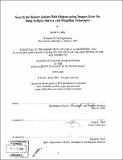Search for binary Kuiper Belt objects using images from the deep ecliptic survey and Magellan telescopes
Author(s)
Eddy, Sarah J. (Sarah Jean), 1979-
DownloadFull printable version (4.514Mb)
Alternative title
Search for binary KBOs using images from the deep ecliptic survey and Magellan telescopes
Other Contributors
Massachusetts Institute of Technology. Dept. of Earth, Atmospheric, and Planetary Sciences.
Advisor
James L. Elliot.
Terms of use
Metadata
Show full item recordAbstract
A method is developed for examining image frames containing Kuiper Belt objects and classifying those KBOs as binary candidate / not binary candidate. This method uses an elliptical point-spread function fitting technique, relying on the fact that a binary KBO system will appear in a.telescope image as an elongated source, with more or less elongation depending on the separation distance and the relative intensity of the two components. Mosaic images for forty-five Kuiper Belt objects from the Deep Ecliptic Survey were tested. Of these, four were binary candidates, twelve others were possible candidates, twenty one were circular within detection limits, and seven lacked the consistent set of field stars necessary for determination. Observations were planned for the nights of April 8-11, 2002 with the Magellan I telescope. However, due to unfavorable observing conditions during the three nights of the run, no good images of the ten candidate binaries and possible candidates visible at the time were able to be taken. This methodology of image analysis should continue to be applied to new KBO images, to identify additional binary candidates. Imaging of the candidates selected through this thesis work will be attempted during future Magellan observing runs, particularly in June 2002.
Description
Thesis (S.M.)--Massachusetts Institute of Technology, Dept. of Earth, Atmospheric, and Planetary Sciences, 2002. Includes bibliographical references (p. 31-33).
Date issued
2002Department
Massachusetts Institute of Technology. Department of Earth, Atmospheric, and Planetary SciencesPublisher
Massachusetts Institute of Technology
Keywords
Earth, Atmospheric, and Planetary Sciences.